
Orchid at home does not bloom what to do advice. Why does the Phalaenopsis orchid not bloom?
All orchids require careful care and maintenance. Only in this case it is possible to achieve the correct development of the plant. Naturally, it is difficult to recreate the tropical climate that orchids love so much in a room. But even in the tropics, greenhouse conditions are not at all, plants just need certain cycles in development. Only in this case, your orchids will delight you with their flowering.
Most often, orchid breeders have phalaenopsis, which should bloom twice a year. Yes, this is possible, but with such frequent flowering, the plant is quickly depleted. If you provide proper care for an orchid, it has enough fertilizer, sunlight, moisture, the temperature regime and the dry period will be maintained, then the plant will definitely delight you with its frequent and long flowering. But in an apartment it is difficult to completely recreate the conditions necessary for flowering orchids.
Orchid bloom at home
Why is the orchid not blooming?As already mentioned, the orchid does not bloom if all the conditions of detention are not met. Beginning orchid breeders try to take care of the plants as best as possible, which makes some mistakes. You should start with the basics: watering, lighting, air temperature.
Orchids in the tropics not getting the right amount of moisture all year round . There is always a dry season that lasts a couple of months. At this time, the rains do not fall, so the plants do not receive the amount of moisture they need. Do not think that there is no water at all. The aerial roots of orchids absorb moisture from the air, besides, there is always dew. Such a forced walk without water stimulates the orchid to start growing flower stalks again. Many housewives forget about this dry period and water the orchid all year round in normal mode. As a result, it turns out that the orchid does not bloom, and only leaves grow in abundance. So, do not forget about the dormant period of the orchid. Once an orchid, reduce watering to a minimum. Resume normal watering when you see the first signs of new flower stalks.
The second equally important factor for flowering orchids is sunlight. All orchids love bright sunlight, without daylight hours of the proper length, the plants will not flower. The worst situation is in winter, when there is practically no light, so the plants will have to illuminate with phytolamps. These are special lamps that give a bright diffused light, but do not dry the air. Use them to illuminate orchids in the autumn-winter period.
The temperature difference is also very important. Many cannot achieve the desired temperature difference, which will last a whole year. In winter, for example, it is impossible to take an orchid out to the balcony at night, as it can be too cold there. But in summer, keeping an orchid in the fresh air will be useful, since at this time there is a natural difference between day and night temperatures. In autumn and spring, when it is still cold outside, but warm inside, ventilate the room more. Only without fanaticism and do not leave the orchid in a draft.
As you can see, in order for your orchid to please you with its flowering, you need to follow three basic rules: watering, light, temperature. Naturally, we must not forget about fertilizers. It will be good if you reduce the amount of nitrogen in fertilizers, since it is this element that inhibits the development of flowers.
Do not forget that each type and variety of orchids requires a special approach. So, some orchids begin to bloom if they arrange a temperature difference for a while. For others, a period of drought is enough. Care depends on which variety or hybrid you grow. And in order for you to care for the orchid correctly, you need know exactly natural conditions plant growth.
 Why the orchid does not bloom, but the leaves grow
Why the orchid does not bloom, but the leaves grow
Buying an orchid with bright inflorescences, I want to see this beauty every day. But over time, the flowers dry up, fall off, and new flower stalks are in no hurry to appear even after a dormant period. In some cases, the plant may not please with flowers for 2 or 3 years. What should flower growers do if their favorite orchid no longer blooms?
Orchid is a very beautiful exotic plant with a rich palette of large colorful flowers. She, like a miracle of nature, captivates with her tenderness, leaving no one indifferent. But even experienced flower growers plant orchids with caution - because of their exactingness and capriciousness.
In nature, plants grow in a tropical climate with alternating periods of drought and heavy rains and high humidity. At home, they need to create exactly the same conditions. Only when they feel a complete resemblance to their native climate, they will reward you with gorgeous and long flowering.
In order to stimulate the plant to bloom, it is advisable to first identify the reasons that prevent it from releasing bright buds. Perhaps, getting to know them, you will already know what to do if your orchid has stopped blooming. Negatively affect flowering:
- transplants during bud opening;
- frequent watering and constant humidity;
- abundant fertilizing with nitrogen fertilizers (in this case, the plant will grow only fleshy leaves);
- warm shower.
Only by eliminating all adverse factors, you can try to "encourage" the plant to bloom, creating certain conditions for it.
Read also:
How to make a beauty bloom?
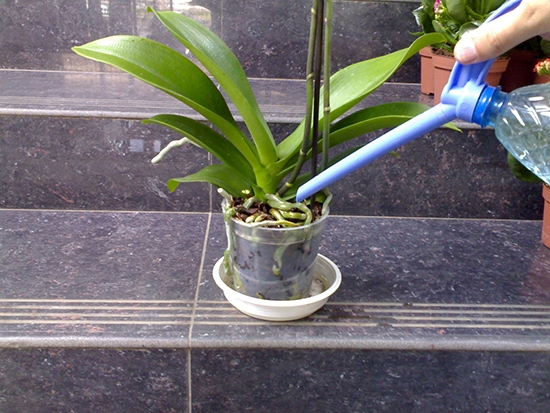
An amazing fact: it is in beginner flower growers that orchids bloom most often. As practice shows, the typical mistakes of such amateurs are the choice of southern windows (and the resulting large temperature difference) and irregular watering (which is what the plant actually needs).
Watering
What to do if orchids do not bloom for a long time? The fundamental answer to this question is proper watering. In order for flower buds to form, it should be limited, and sharply. This simulates a dry period in the tropics, in the homeland of the plant.
At home, watering the orchid is stopped for 10-12 days, be sure to lower the ambient temperature at night by at least 3 degrees, then raise it again. Watering must necessarily alternate with periods of "drought" so that the roots of the orchid and the soil are completely dry.
For the formation of full-fledged peduncles, almost all types of orchids need a long daylight hours - 14 hours. Indoors, sufficient lighting for plants can only be provided with the help of artificial light sources. An ordinary ceiling chandelier alone will not be able to cope with such a mission. As additional lighting, use only fluorescent lamps with a power of no more than 40 W, placing them no closer than 30 cm from the tallest orchid. At the same time, even a slight distance of the light source from the plant many times reduces its chances of flowering. Do not use conventional incandescent bulbs because they heat up the leaves and cause burns.
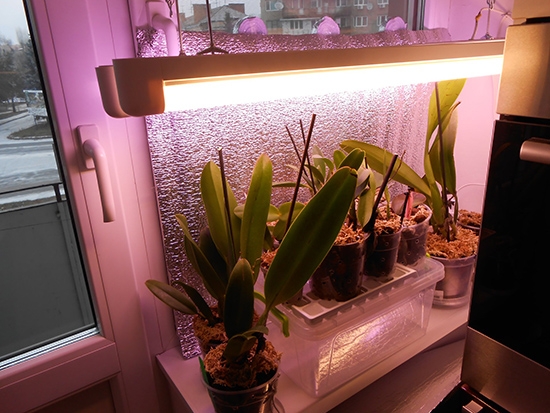
Different types of orchids require different natural light. Some feel great, basking in the sun, and grow magnificently on the southern windows without any partial shade. For others, direct sunlight, on the contrary, is contraindicated due to the sensitivity of their foliage. So, if it is cattleya, paphiopedilum, phalaenopsis, then the best place for their growth is the eastern windows. If the windows of the apartment face south side, put orchids at a distance of 60 cm from a brightly lit windowsill.
Dendrobium, brassia, epidendrum, oncidium bloom well only in moderate light. The ideal place for them is the western windows. On the south side, they should be no closer than 30 cm from the windowsill.
Vanda and hybrids of this species require good lighting. They can be safely placed on the windowsills of the southern windows: the foliage is not afraid of burns.
It is noteworthy that when all the flowers bloom on the orchid, it can be placed in any dark corner of your house.
Temperature regime
What if the orchid has not bloomed for 2 years, despite the fact that you provided it with proper watering and sufficient lighting? It could be the ambient temperature. Coolness (16-20 0 C) is most favorable for these exotic plants.
The absence of flower stalks or their complete shedding during the flowering period can be caused by drafts or airflow from split systems blowing plants.
How to properly feed a capricious?
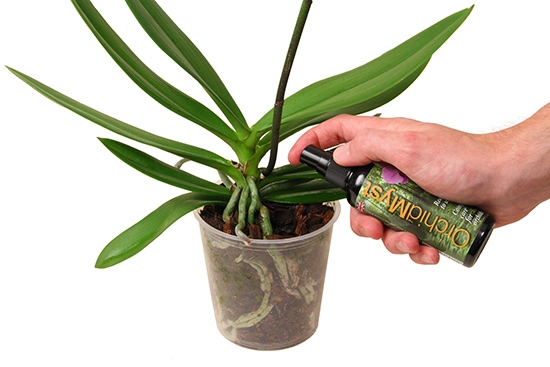
Novice flower growers often make the same mistake by feeding orchids in strict accordance with the fertilizer instructions - 2 times a week. And, as a result, they often wonder what to do if the orchid does not bloom, but only releases leaves. In this case, you will have to stop feeding.
Fertilizers can be applied to the soil substrate only when clearly distinguishable flower stalks appear on a tropical crop. From this point on, you need to feed regularly until the first flower blooms. Once the plant has bloomed, no further fertilizer can be applied. Even a small amount of them can provoke the fall of flowers and buds that have not yet opened.
Before buying special fertilizers for orchids, be sure to familiarize yourself with the constituent elements and their proportions. Nitrogen and potassium should be present in equal amounts, the phosphorus content may be slightly higher.
But still, the best “feeding” for a beautiful orchid is the lighting she needs. exotic plants require certain growing conditions, and pampering them with fertilizers is superfluous.
Orchids have become a beautiful addition not only to ordinary apartments, but also to restaurants, cafes, and hotels. Tall flower stalks with flowers of different shapes and colors create an atmosphere of luxury. Blooming flowers keep open for up to twelve weeks, and with good care at home, the orchid blooms twice a year. The main thing is to know the reasons why the orchid does not bloom and how to stimulate the beauty to bloom.
How long can an orchid bloom at home
The most popular orchids can rightfully be considered Phalaenopsis and Dendrobium, less popular orchids are Cymbidium and Paphiopedilum. But there are a lot of species and hybrids of orchids; they all differ from each other in shape, size, flower color, leaf shape and flowering period, as well as the presence or absence of a smell.
Orchids can delight with their flowering up to twelve weeks.
Orchid flowering begins at the end of the growing season. A peduncle appears that grows up about 1 cm per day, then it branches and picks up buds. After about 4-6 weeks, a nondescript branch is covered with beautiful flowers that stay on the plant for up to three months. After a short rest, a repeated vegetative period begins again. A flower arrow reappears on the orchid or new buds on the old one. If your orchid does not bloom at least once a year, then you are doing something wrong.
Photo gallery: the most common varieties of orchids
Phalaenopsis orchid - one of the most unpretentious and common orchids in indoor floriculture Dendrobium blooms very beautifully, but is less common than Phalaenopsis The Cymbidium orchid has long thin leaves Paphiopedilum flowers are bowl-shaped
How to care for a beautiful orchid during flowering
The orchid is native to the tropics. It survives both droughts and high temperatures with an abundance of moisture. After the rains, the plant begins to powerfully grow leaves, roots, accumulate strength, and only then blooms. For an orchid, indicators such as proper lighting, humidity, temperature are very important.
Choosing the Right Light for Flower Growth
Each type of orchid is individual. As for the Phalaenopsis orchid, it prefers bright diffused light without direct sunlight. A great place for her would be the sill of the east window.
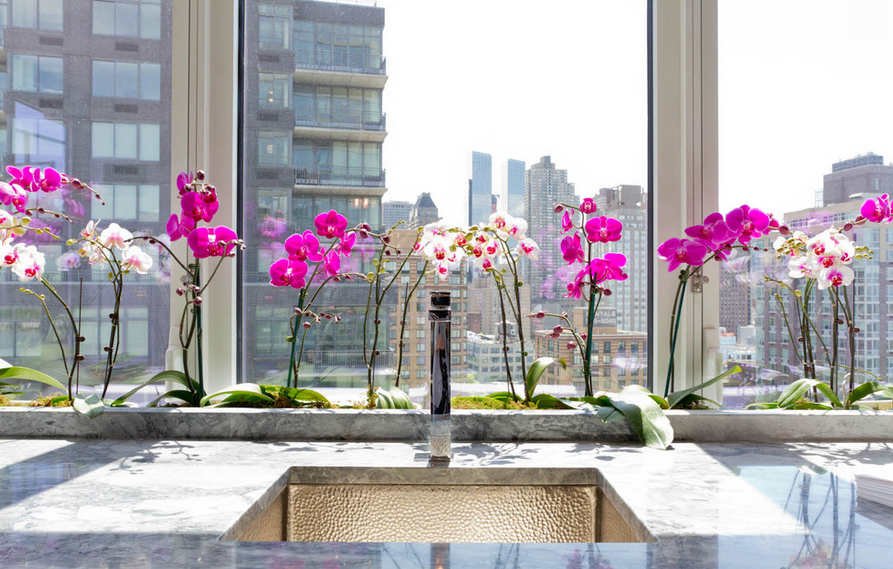 Phalaenopsis likes bright light without direct sunlight.
Phalaenopsis likes bright light without direct sunlight. On the south or west window, the orchid must be separated with a tulle curtain. The duration of daylight hours is also important, which should be at least 12 hours.
 In a bright room with windows on the south side, the orchid can be placed not at the window
In a bright room with windows on the south side, the orchid can be placed not at the window
How humidity and watering affect the roots and growth of orchid arrows
Watering orchids is carried out by immersing the pot in a bucket of water or a deep pan. The roots and soil should be allowed to soak for about 30 minutes and drain excess water. It is useful to spray the upper part of the substrate with a spray bottle. During the rest period, orchids are watered less often - only after the roots of the plant change their green color to grayish. In dry climates, it is important to maintain high humidity around the orchids, this can be achieved by placing the pot on a tray of wet claydite. At the same time, it is very important that the pallet is wide and the evaporation area is large.
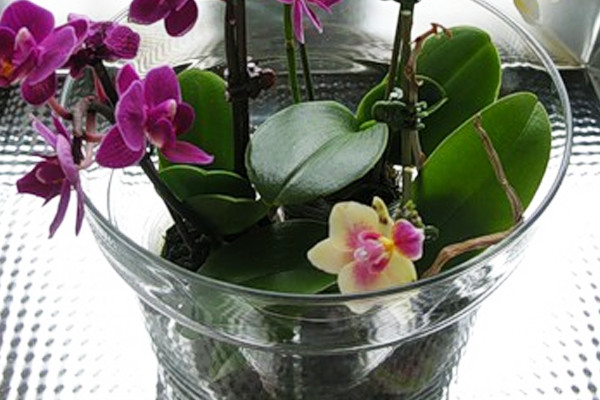 A humid atmosphere should be maintained around orchids.
A humid atmosphere should be maintained around orchids. Choosing the Right Temperature for Orchid Growth and Flowering
It is believed that temperature changes can stimulate the flowering of orchids. It is enough that the daytime temperature differs from the nighttime temperature by 3-5 degrees. It is quite possible to do this on a window. The optimum temperature for orchid growth in summer is 25–30 degrees; in winter, plants can be kept at 18 degrees.
Table: lighting, temperature and watering have a great influence on the growth and flowering of different varieties of orchids
| orchid variety | Location and lighting | daytime temperature | Watering frequency |
| The plant can be installed on the western and eastern window sills. | 18-25ºC | Normal humidity is 30–40%. Watering is carried out after the soil has completely dried. | |
| Flowers like good lighting, but without direct sunlight in the afternoon. | 15-25ºC | The optimum humidity is 25–30%. An increase in humidity gives rise to new sprouts. | |
| The plant needs a lot of fresh air and light. At least four hours a day, the flower can be exposed to the open sun. Bright but soft autumn sun is the best “helper” for flowering. | Withstands 35-38°C | During the period of active growth requires abundant watering. Allow the soil to dry out between waterings. | |
| Dislikes bright sunlight. From the touch of direct sunlight, burns appear on the leaves. Flowers will take root on the northern windows, but the eastern direction is also suitable. |
18-25°C | Needs abundant and frequent watering. Excess water must necessarily flow out through the drainage holes of the pot. |
Why fertilizing helps to stimulate the growth of flower stalks
Like other plants, the orchid needs mineral and organic fertilizers, but in much smaller quantities. Usually, top dressing begins with the beginning of the growing season of the orchid. It is not difficult to determine it: new roots and leaves appear. It was at this time that the orchid was intensively watered and fed. But if the proportion of nitrogen in top dressing is large, then the orchid will only grow leaves, so it is important to use special means for fertilizing orchids. As soon as you find a peduncle that has appeared, stop feeding, they can cause the buds and peduncle to dry out. To determine if an orchid has a peduncle or root, pay attention to the color. The peduncle is usually green and grows upwards, while the root is dark-tipped and directed downwards.
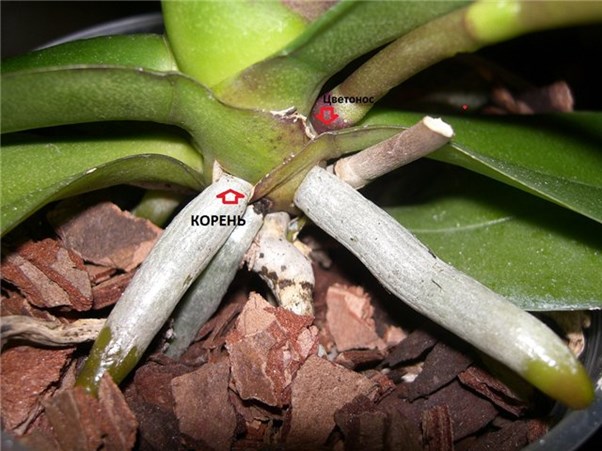 The root of an orchid can be distinguished from a peduncle by color: dark color at the tip of the root, it grows down
The root of an orchid can be distinguished from a peduncle by color: dark color at the tip of the root, it grows down How to achieve new flower stalks in orchids
So, your Phalaenopsis bought in flowering has already faded from six months ago and it's time for it to bloom again. Before you stimulate the plant to bloom, check if your orchid is healthy? Only after a careful examination for the presence or absence of rot and other signs of disease can the following methods be used.
Small young plants that have not reached the age of two or three may also not bloom.
Evaluate the plant, how many young leaves have grown recently? How many roots have appeared, whether they are in active growth or "freeze". Young roots differ from old ones in a delicate green color. If Phalaenopsis has not been growing for a long time, then it simply “fell asleep”.
The reason for the appearance of the orchid peduncle: stress
If the orchid grows well for several months, produces new leaves and roots, but there is no peduncle, it is necessary to create a stressful situation.
- Put the orchid in a bright place with a day length of 14-16 hours.
- In winter, to lengthen daylight hours, use artificial lighting with lamps.
- Take care of high humidity with wet moss or expanded clay pallets.
- Feed the plant with special products, tablets or paste.
For the appearance of arrows, it is most preferable to change the irrigation scheme and create a dry season - water much less often with the substrate completely drying out in 2–3 days. This mode must be maintained until the first rudiments of the flower arrow appear. With high humidity, the orchid can be completely dry season without watering for 3-4 weeks.
In late spring or early autumn, you can take the orchid to the balcony so that it is kept at a temperature of 20–23 ° C during the day and at 10–13 ° C at night. Such a sharp temperature drop stimulates flowering very well. In winter, the temperature difference can be made on the windowsill. However, if the battery is very hot, then it is better to separate the window with foil foam rubber at night so that the heat of the room does not pass to the window sill, and remove it in the morning. But still, a natural temperature drop in the open air is preferable.
Video: how to make an orchid bloom again
There are special tablets and ointments to stimulate flowering. The most commonly used tablets are succinic acid and cytokinin paste.
For additional stimulation of flowering, orchids use preparations for feeding - "Bud", "Ovary", "Pollen".
Succinic acid as a means of stimulating the appearance of a peduncle
Succinic acid strengthens, stimulates and supports plants. After the application of succinic acid, roots and leaves begin to actively grow in orchids, and flower buds awaken.
How to use succinic acid correctly:
- Dilute 1 tablet in 0.5 liters of water (if in bulk, then on the tip of a knife).
- Pour water into a spray bottle and spray leaves, aerial roots, root neck.
- Pour the soil with the rest of the solution or soak the orchid in it for 6–8 hours.
Spraying does not replace top dressing, therefore, after stimulation, the orchid must continue to be fed with complex fertilizers. Succinic acid is best used every three weeks for the growth of new shoots.
Using cytokinin paste for reblooming
Cytokinin paste is a hormonal preparation based on cytokinin. Thanks to him, dormant buds awaken on the plant, cells begin to actively divide. The paste gives 100% orchid babies. Cytokinin should be used in the warm season, or provide the orchid with conditions comparable to summer content (bright lighting and heat).
Application of miracle paste:
- The paste is smeared with buds on an already existing peduncle. As a rule, choose the lowest or upper kidney.
- Gently remove the upper dry scale with tweezers or a knife, under which a small green kidney is found. It is necessary to try and not damage both the bud itself and the peduncle.
- Cytokinin paste is squeezed onto the tip of a toothpick and transferred to the kidney. Pea paste - up to 2 mm. For better penetration of the paste, you can gently scratch the kidney with a sterile needle with gentle and smooth movements.
- Spread the paste over the entire surface of the kidney.
In a week, either a new peduncle or a baby will appear from this bud. Do not abuse the stimulation paste. It is enough to process 2–3 buds (more can be done on a powerful plant), since the orchid will then have to grow this baby or peduncle.
Indications for the use of cytokinin paste:
- deplorable or critical condition of the plant;
- to awaken a flower from a long winter "hibernation";
- uneven development of the plant.
Do not use cytokinin paste to stimulate flowering in the following cases:
- orchid damage by disease or pests;
- the orchid is already blooming profusely and the awakening of extra buds weakens the plant;
- no need to awaken more than three kidneys with paste;
- do not smear the roots and leaves of the orchid;
- do not use on young orchids and transplanted babies.
Video: applying cytokinin ointment to an orchid bud
The orchid stopped blooming: problems and solutions
If you properly care for the orchid, it will bloom for a very long time.
| Description of the problem | Cause | Solution |
| Orchids only grow large leaves and roots. | Growing season, excessive nitrogen fertilization | After winter, the plant increases its green mass and the orchid will bloom only with the end of the growing season. Water the flower with fertilizers with a predominance of potassium and phosphorus. |
| Orchid not blooming after transplant | The plant restores strength, grows roots | For better survival after transplantation, pour "Epin" or succinic acid - this will strengthen the orchid and help awaken dormant buds. |
| Orchid has released an arrow, but does not bloom | An individual feature of an orchid | An orchid can pick up buds, but not bloom them for up to three months. Try feeding with half the fertilizer. |
| Orchid does not bloom for more than a year | Wrong care | Lack of light, regular frequent watering, the same day and night temperatures lead to the fact that the orchid grows, but does not bloom. Stress the plant:
|
| Orchids drop buds |
|
|
What to do if the orchid does not bloom, develops well? You will need to provoke the release of the arrow. The aerial root and arrow look the same at first. But the tip of the arrow is rounded, and at the root it is sharp, as in the photo.
How to make an orchid bloom
Orchid is a plant of the tropics that does not know what winter and summer are. But she distinguishes between the season of warm tropical rains and drought. Climate change can trigger flowering. The condition of stressful actions is the health of the plant. A weakened flower can be destroyed.
The use of stimulants in the form of Epin, succinic acid, daily morning spraying on the aerial parts and weekly watering with the addition of the drug can add energy, and the plant will throw out the arrow.
If you water orchids from above, then the water is filtered and takes out excess salts. Simultaneously with water, oxygen is delivered to the roots.
 Why does the orchid not bloom, but the leaves grow? So, in the diet they gave an excess of nitrogen. A well-managed dry season can help. After a month or two, flower buds will appear if you create a lack of moisture, but at the same time the temperature should not be higher than 30 0 С:
Why does the orchid not bloom, but the leaves grow? So, in the diet they gave an excess of nitrogen. A well-managed dry season can help. After a month or two, flower buds will appear if you create a lack of moisture, but at the same time the temperature should not be higher than 30 0 С:
- Increase root dry time between waterings to 4 days in warm conditions, up to a week if the room is cool.
- Do not carry out spraying, top dressing, fight so fight!
- A peduncle will appear and resume plant care, only exclude fertilizing watering.
- Organize proper lighting, in winter, additional lighting at a distance of no more than 40 cm from the top of the head.
- If the "drought" is carried out correctly, the peduncle will grow and the lower leaves will become softer than usual.
What to do to make the orchid bloom after the “rainy season”? We use only water heated to 35 degrees for water procedures. There are many ways to induce an orchid to bloom.
Water 3-4 days in a row, then let the plant dry out for two weeks. After that, care should be carried out as usual.
Three times a day for a week from a spray bottle with warm water with Epin or succinic acid for a week.
In a warm steam room, water the plant from the shower with water at 35 degrees for 15-20 minutes. Let the bathroom cool down with the flower so that the steamed plant does not catch a cold.
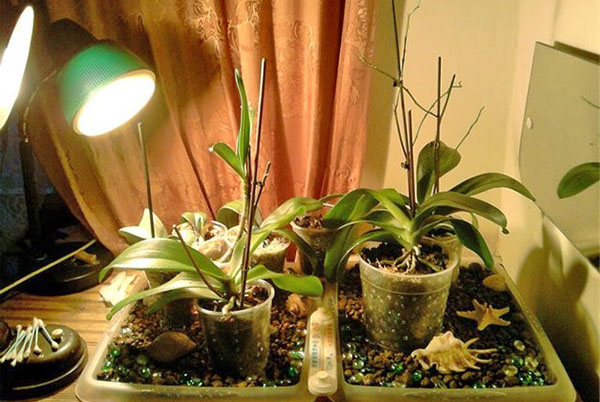 You can use only one of the methods to accelerate flowering.
You can use only one of the methods to accelerate flowering.
The question of why an orchid does not bloom at home may have an unexpected answer. You smoke, and the flower cannot stand the smell of tobacco smoke. Do you always have a bowl of fruit on your table? But the flower does not like ethylene, which is released by ripening fruits. When harvesting, the flower is rearranged from place to place? Can't wait to bloom. When purchasing a flower, you need to notice how it stood, and keep the orientation as possible.
How to achieve flowering orchids - video
In an ordinary city apartment, it is quite difficult to recreate conditions similar to tropical ones, which are most suitable for the development and flowering of orchids. But, despite this, for a stable flowering of a plant, it is enough to observe a number of conditions and a certain cyclicity.
Several reasons why the orchid does not bloom
Temperature
Orchids are capricious and very dependent on the temperature in the room. The temperature is different during the day and at night, and this affects the flowering of orchids.
Irrigation mode and amount of water
Even if you regularly and abundantly water the flower, this will not guarantee that the plant will feel comfortable. In a dry environment, orchids give off a lot of water through their leaves, so they need extra moisture to bloom. It may be the other way around - the flower grower does not water the flower often enough and well, the soil dries up and the plant has enough moisture only to survive. If the leaves of a flower are wilted and shriveled, then it does not have enough water.
lack of light
Orchids come in several varieties. All species require different care. The most common Phalaenopsis orchid does not like direct light, especially in autumn and spring.
Nutrient deficiency
All plants need nutrients, and orchids are no exception. Many people use phosphorus-potassium fertilizers, but they stimulate the growth of new leaves, but not flowers. Therefore, certain fertilizers are needed to feed orchids.
How to create favorable conditions for flowering?
Develop a watering schedule
If flowers grow in nature, then they “know” that “dry” days follow heavy rains, so they form flower stalks. For orchids that grow at home, you need to do the same.
First, water regularly and abundantly, and then sharply reduce watering, since monotonous abundant watering causes development only in the leaves. If you notice that the bulbs are ¾ developed, then it's time to reduce the amount of moisture. It is necessary to spray only the leaves, and rarely water the soil. Such cyclicity, characteristic of the natural environment, will help the plant to bloom, even if it has not bloomed for a long time.
Improve lighting
When choosing an orchid from the catalog, you should pay attention Special attention on the description of the flower, which indicates all the information on caring for it, including information about how the lighting should be. Sometimes it is necessary to purchase a fluorescent lamp in order to achieve the desired light intensity.
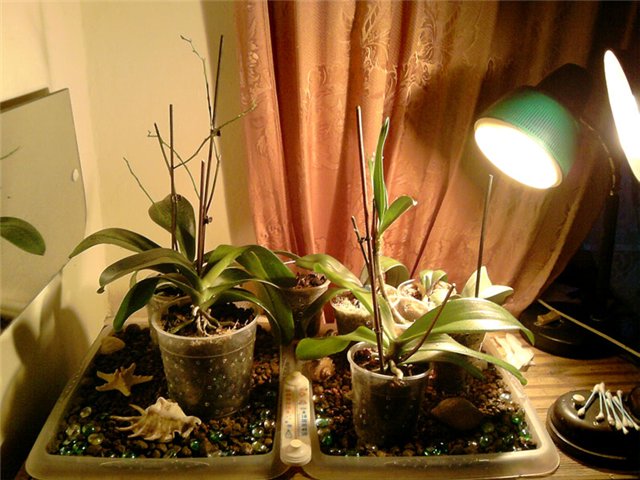
Home conditions are very different from natural ones, so a phytolamp is often needed to create a natural habitat. Many types of orchids prefer a long daylight hours, and they need to create it. It happens that beginners place flowers on the south windows, and the plant begins to bloom, while experienced breeders do not bloom orchids, because they stand on the windowsills that face the north side.
Choose the temperature
A common reason why a plant does not bloom and the leaves grow is the wrong temperature of its content. Each type of orchid requires an individual temperature regime. In order to control the temperature, you need to purchase a thermometer.
A flower can bloom from a temperature difference of only 3-5 degrees Celsius. For example, you can place a flower from a warm room into a cool one, and it will bloom. In the summer, it is useful to transfer the orchid to the balcony, natural temperature changes can serve as an impetus for it to bloom. In the autumn-spring period, it is enough to ventilate the room more often, while making sure that the flower does not fall under the draft. There are also species that need not only a certain temperature, but also a certain season.
Apply fertilizer
In a specialized store, you can buy suitable fertilizers for orchids. Most often they are sold in liquid form. Elements contained in fertilizers can stop flowering, like nitrogen-containing fertilizers, or they can speed it up. In such situations, it is recommended to consult a store specialist so that he selects the right fertilizer for this type of flower.
Explore the habitat of an orchid
It happens that the grower meets all the conditions for watering and fertilizing, but the orchid still does not bloom. To achieve its flowering, it will be useful to study in detail the habitat of the orchid, all the conditions for the normal life and development of this plant. Often, certain conditions seem unusual to owners of orchids, but they are necessary for its flowering.
If the orchid does not bloom after transplantation, in this case you need to be patient, since a fairly long period of time can pass between the laying of flower roots and flowering. But it may also be the other way around that the flower has stopped blooming because its roots do not have enough space. Then, in order for the orchid to bloom, it is necessary to transplant the flower into a large container.